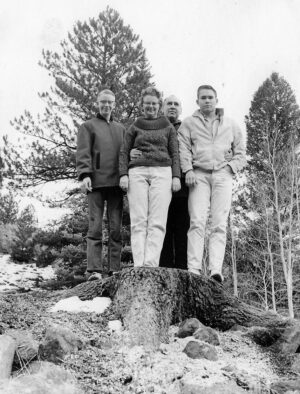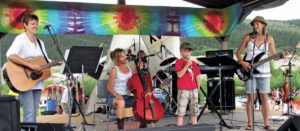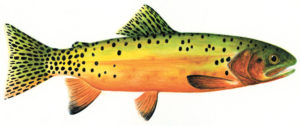by Charles F. Price
Was Salida the jumping-off point for the last killing in the West’s most famous vendetta, the one spawned by the so-called Gunfight at the OK Corral?
At least one recognized historian thinks so. Karen Holliday Tanner, whose collateral ancestor was the Georgia-born gambler/gunman/failed dentist Dr. John H. (“Doc”) Holliday, writes in a 1998 biography of her famed forebear that when he stepped off the train in Salida in the summer of 1882 he quickly met with Wyatt Earp and others west of town and in a roundabout trek by horseback and train slipped secretly into southeastern Arizona to slay John Peters Ringo, one of the last remaining members of the cowboy gang they had battled in Tombstone earlier that year.
Doc did spend time in Salida. Tanner quotes the Mountain Mail of Saturday, July 8, 1882: “Doc. Holliday, late of Arizona is in town…” Why? Was it to rendezvous with the Earp party and hunt down Ringo, who Wyatt suspected had masterminded the assassination of his brother Morgan in Tombstone the previous March? Tanner lays out an elaborate itinerary based on that assumption. Once Doc joined the Earp party outside Salida, she contends, they rode through Poncha Pass and down to Alamosa, hopped the Denver & Rio Grande to Española and Santa Fe, then took the trunk line to Lamy.
She writes, “There the Santa Fe Railroad was the logical choice to go south to Deming via Albuquerque. At Deming a transfer to the Southern Pacific would have allowed them to continue their trip west. Presumably, they got off the train upon reaching Lordsburg … where Wyatt had a contact, a Wells Fargo undercover agent, who was working as a blacksmith. As described, the entire journey from Salida could be done in three to four days, allowing the foursome to arrive in the Lordsburg area on July 10 or 11.” On July 13, 1882 Ringo was found dead in Turkey Creek Canyon in the Chiricahua Mountains of southeastern Arizona, which Tanner seems to have concluded was a not-unreasonable horseback ride from Lordsburg in the time available.
Any yarn that involves the word “presumably,” plus a conveniently-placed undercover agent posing as a blacksmith but playing no described role in the plot, together with a preposterously complicated horseback/railroad journey compressed into an implausible time-frame, can’t help raising an eyebrow of doubt. And for good reason. It most likely didn’t happen.
Tanner’s book is called Doc Holliday: A Family Portrait. It was released by the prestigious University of Oklahoma Press, arguably America’s premier publisher of Western history books. It includes much important information about Doc’s private life. But in asserting that Doc and the Earps went to such elaborate lengths to put Ringo under the daisies, Tanner is distinctly in the minority, following a spurious trail laid down before her by a coterie of pseudo-historians cynically manipulating the record and even falsifying evidence.
More scrupulous and less credulous researchers insist that Ringo, a self-hating alcoholic, committed suicide all by himself. He was found sitting in the crotch of a tree with a bullet hole in his temple and a Colt 45 caught in his watch chain, an expended shell under the hammer. Interestingly, at the likely time of Ringo’s death it can be conclusively established that Wyatt Earp was in Gunnison and Holliday was in District Court in Pueblo.
So why did Holliday get off the train in Salida? Fact is, he was coming from Gunnison where he’d indeed been visiting Wyatt Earp and his brother Warren — not to conspire to murder John Ringo, but to mend fences with Wyatt. They had argued earlier in the year. Now he was on his way to make his Pueblo court date, and had probably decided to break his trip to see the sights of Salida and try his hand at his favorite card game, faro.
In appearance and demeanor Doc never seemed to measure up to his fearsome reputation. He nearly always behaved in a self-effacing and modest manner, and must have done so in Salida, since the Mountain Mail is silent about his comings and goings during his visit. Days before, approached by a reporter in Gunnison, he’d good-naturedly remarked, “I’m not traveling about the country in search of notoriety, and I think you newspaper fellows have already had a fair hack at me.” Indeed they had. Ever since the shootings in Arizona, the press had made him out the coldest-blooded killer in the Earp faction — and that was saying something.
To buttress the supposed Ringo murder plot, Tanner quoted only a portion of the Mountain Mail account of Holliday’s visit. Not that the article was all that prominent. The editors buried it on page four toward the bottom of the catchall “Local News” column. Maybe Holliday was a frequent passer-through and no longer merited special mention (Salida was the train-changing station to any place of significance in the region). Or perhaps the editor of the Mail was simply unimpressed by migrating gunfighters.
After noting his arrival, the Mail article said he was accompanied by “Osgood and Robinson” — Sam Osgood and “Texas George” Robinson, gambler friends of Holliday’s from Denver — and remarked, “They will remain several days.” The item gave short shrift to the sensational events in Tombstone, probably because the story was several weeks old by then and widely-known: “The Arizona authorities tried to get Holiday (sic) back to that territory on a charge of murder but Governor Pitkin refused to honor the requisition.”
It was true that Arizona held murder warrants for Holliday and the Earps. After the shootout at the OK Corral and Morgan’s murder, Wyatt and Warren, Doc, and a party of gunman pals, armed with federal deputy marshals’ badges, had set out to exact revenge. They killed some suspects in a savage outburst since called by some “The Vendetta Ride.” The dead included Frank Stilwell in Tucson, Indian Charlie or Florentino Cruz in the Dragoon Mountains, and possibly Curly Bill Brocius at Iron Springs in the Mustang Mountains.
But they missed Ringo. They missed him because they had to skip out of Arizona and into Colorado ahead of several posses composed mostly of political enemies and pals of the ones they’d used up. Arizona tried to extradite the Earp party for murder but Colorado Governor Frederick Pitkin refused — the Earps and Pitkin were good Republicans and detested the cowboy-coddling Democrat authorities of Arizona’s Cochise and Pima counties, where all the bloody troubles had played out.
Next month: Bat Masterson files a larceny complaint against Holliday which is slated for a July hearing in Pueblo.
Charles F. Price is a writer living in Burnsville, NC. He has published five works of historical fiction and has just finished a new novel about the murder raid of the Espinosas though Central Colorado in 1863. He has maintained a lifelong interest in the history of the American West.


